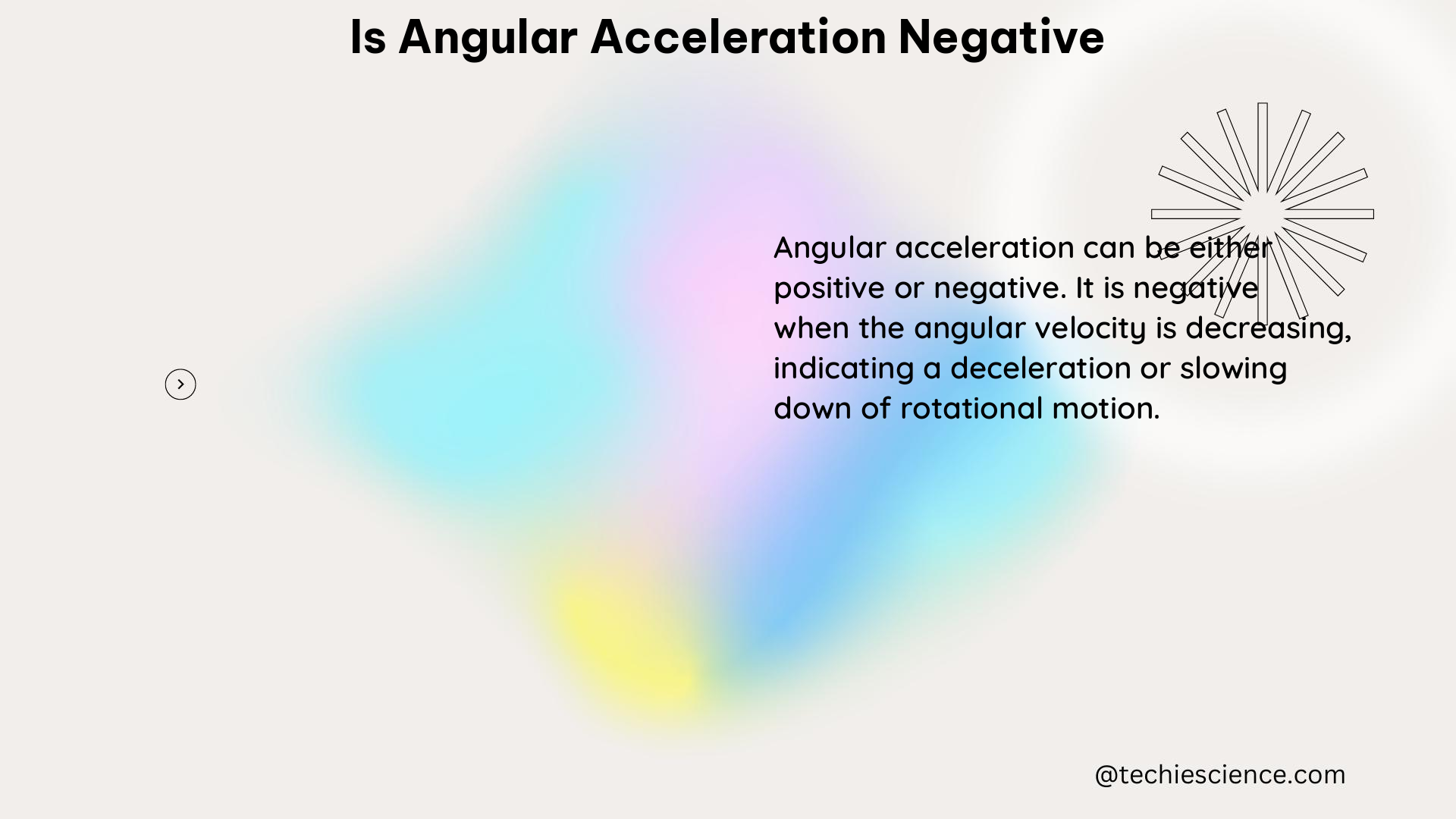Angular acceleration can be positive, negative, or zero, and it plays a crucial role in the study of rotational motion. A negative angular acceleration indicates that the angular velocity of an object is decreasing or becoming more negative over time. This concept can be represented mathematically and has various practical applications in physics and engineering.
Understanding Negative Angular Acceleration
The relationship between angular velocity (ω), initial angular velocity (ω₀), angular acceleration (α), and time (t) can be expressed as:
ω = ω₀ + αt
When the angular acceleration (α) is negative, it means that the angular velocity (ω) is decreasing over time. This can be visualized as the object slowing down or decelerating in its rotational motion.
Negative Angular Acceleration Formula
The formula for negative angular acceleration is the same as the general formula for angular acceleration:
α = (ω – ω₀) / t
Where:
– α is the angular acceleration (in rad/s²)
– ω is the final angular velocity (in rad/s)
– ω₀ is the initial angular velocity (in rad/s)
– t is the time elapsed (in seconds)
If the final angular velocity (ω) is less than the initial angular velocity (ω₀), then the angular acceleration (α) will be negative, indicating a deceleration in the rotational motion.
Examples of Negative Angular Acceleration
- Rotating Disc: Suppose a rotating disc changes its angular speed from 100 rad/s to 40 rad/s in 10 seconds. The angular acceleration during this time would be:
α = (ω – ω₀) / t
α = (40 rad/s – 100 rad/s) / 10 s
α = -6 rad/s²
This means that the angular velocity of the disc is decreasing at a rate of 6 rad/s every second.
- Bicycle Wheel: Consider the rear wheel of a bicycle having an angular acceleration of -20 rad/s². This indicates that the angular velocity of the wheel is decreasing at a rate of 20 rad/s every second, resulting in a deceleration of the wheel’s rotational motion.
Negative Angular Acceleration in Rotational Dynamics
Negative angular acceleration is often associated with the concept of rotational dynamics, which deals with the relationship between torque, angular acceleration, and the moment of inertia of an object.
The equation of motion for rotational dynamics is:
τ = Iα
Where:
– τ is the net torque acting on the object (in N·m)
– I is the moment of inertia of the object (in kg·m²)
– α is the angular acceleration of the object (in rad/s²)
If the net torque (τ) acting on the object is in the opposite direction of the object’s angular velocity, the angular acceleration (α) will be negative, indicating a deceleration in the rotational motion.
Practical Applications of Negative Angular Acceleration

Negative angular acceleration has various practical applications in different fields, including:
-
Braking Systems: In vehicles, negative angular acceleration is used in braking systems to slow down or stop the rotation of the wheels. The brake pads apply a frictional force that creates a negative torque, resulting in a negative angular acceleration and a decrease in the angular velocity of the wheels.
-
Rotational Machinery: In industrial machinery, such as motors, generators, and turbines, negative angular acceleration is often used to control the speed and prevent damage to the system. When the load on the machine increases, the angular acceleration may become negative, causing the machine to slow down and maintain a safe operating speed.
-
Sports and Biomechanics: In sports and human movement analysis, negative angular acceleration is observed in various activities, such as the deceleration phase of a baseball pitch, the landing phase of a gymnastic routine, or the braking action of a cyclist.
-
Robotics and Automation: In robotic systems and automated machinery, negative angular acceleration is used to control the motion and prevent damage to the components. Precise control of angular acceleration is crucial for the smooth and safe operation of these systems.
Conclusion
In summary, angular acceleration can be positive, negative, or zero, and understanding the concept of negative angular acceleration is essential in the study of rotational motion. Negative angular acceleration indicates a decrease in the angular velocity of an object, which can be represented mathematically and has various practical applications in physics, engineering, and other related fields.
References:
- BYJU’S. (n.d.). Angular acceleration. Retrieved from https://byjus.com/physics/angular-acceleration/
- Biomechanics of Human Movement. (n.d.). 5.1 Angular Position and Displacement. Retrieved from https://pressbooks.bccampus.ca/humanbiomechanics/chapter/6-1-rotation-angle-and-angular-velocity-2/
- Physics Stack Exchange. (2013, January 6). What is negative angular acceleration? Retrieved from https://physics.stackexchange.com/questions/48466/what-is-negative-angular-acceleration
- Nelson, P. (2012). KINEMATIC CONCEPTS OF HUMAN MOVEMENT. Retrieved from https://cpb-ap-se2.wpmucdn.com/learn.stleonards.vic.edu.au/dist/7/166/files/2012/12/Unit-3-Ch-4-Nelson.pdf
- Quizlet. (n.d.). Nardi Final Flashcards. Retrieved from https://quizlet.com/694196119/nardi-final-flash-cards/
Hi…..I am Harshitha H N. I have completed my master’s in Physics from the University of Mysore with a specialization in Nuclear physics. I enjoy exploring new things in my free time. My article always aims to develop and bring some value to the table with relevant topics.
Let’s connect through LinkedIn-